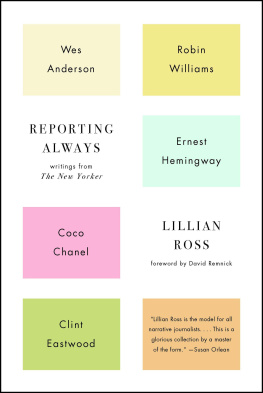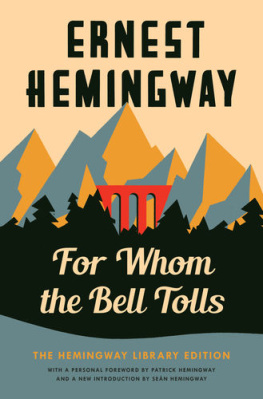ERNEST HEMINGWAY PORTRAIT. PHOTOGRAPH IN HEMINGWAY COLLECTION, JOHN F. KENNEDY PRESIDENTIAL LIBRARY AND MUSEUM, BOSTON.

ERNEST HEMINGWAY WITH SONS (PATRICK, JOHN BUMBY AND GREGORY GIGI), AT CLUB DE CAZADORES DEL CERRO, CUBA, 1945. PHOTOGRAPH IN HEMINGWAY COLLECTION, JOHN F. KENNEDY PRESIDENTIAL LIBRARY AND MUSEUM, BOSTON.
FOREWORD: A MISSING ARTIFACT

The artifacts in the Hemingway Collection at the John F. Kennedy Library play an important role in presenting him and the period in which he wrote. Sadly, many important artifacts did not survive to make it to the Library or anyplace else. One of these, the trout fishing trunk, especially brings back memories to me of the late 1930s, when my father was still married to his second wife, Pauline, my mother.
Fly-fishing is not the only way to catch a trout. Hemingways early masterpiece Big Two-Hearted River, Parts 1 and 2, is about a war-shattered young man seeking sanity by going back to basics. He uses live grasshoppers for bait. So might have done the five-thousand-year-old iceman of the Alps.
My father taught me how to catch trout with two kinds of live bait, grasshoppers and what he called hellgrammites, the larval stage of the dobsonfly. The river he taught me to fish with these two live baits was the upper reaches of the Clarks Fork of the Yellowstone River, which flowed only a few yards away from our rented log cabin at the L-T dude ranch. This mountain free-stone stream was not suitable habitat for the dobsonfly, which is at home in the warmer streams of the Great Smoky Mountains National Park and eaten more by bass than trout. More likely, the creature he showed me how to catch was the larva of a stonefly, but maybe not. What I do know is who taught my father about hellgrammites: his father, Dr. Clarence Hemingway.
While he was an undergraduate at Oberlin College, along with a classmate, H. C. Beardslee, Jr., the son of Dr. Henry C. Beardslee, botanist of the state of Ohio, my grandfather collected plants in the Great Smoky Mountains during the summer of 1891. Besides plants, my grandfather collected hellgrammites as well, which he took home to Oak Park and must have later shown to my father.
In the 1930s, there were very few if any fly shops in the northern Rocky Mountains country, so people had to buy their gear ahead of time elsewhere and bring it with them, a situation similar to what my wife and I faced when we went to fish in Chile in the 1980s. My father ordered the gear for himself and his wife from Hardy Bros. Ltd. in England, using their famous Anglers Guide and Catalogue . It featured high-quality illustrations of rods, reels, flies and all the other bits and pieces of gear, the prices of which were listed in pounds, shillings and pence, abbreviated sd. Along with all the collections of fly reels, rods, vests, boxes, leaders etc. retained from past years, there was new stuff ordered for the year from the current catalogue. For me the currency puzzle was only resolved a few years later when Mr. Brody, my high school Latin teacher, explained about the Roman coins that were minted from a pound of silver. That fishing trunk for me enhanced the elegant ritual of my mom and dad as they waded side by side six feet off each bank downstream, casting toward each other their terminal cluster of three wet flies, letting their lines drift and straighten out before raising their rods and casting again.
Even the finest bowl and bell will crack, and the marriage was lost in the Spanish Civil War, the trunk in the decline and fall of the Railway Express Agency after World War II.
Patrick Hemingway

PATRICK MOUSE HEMINGWAY AND GREGORY GIGI HEMINGWAY, SMILING. I ASKED THE TWO OF THEM TO LET ME TAKE THEIR PICTURE, 1942. COPYRIGHT JFK LIBRARY.
(LEFT TO RIGHT) GREGORY GIGI HEMINGWAY, ERNEST HEMINGWAY AND PATRICK MOUSE HEMINGWAY DUCK HUNTING IN IDAHO. COPYRIGHT JFK LIBRARY.
PHOTOGRAPH IN HEMINGWAY COLLECTION, JOHN F. KENNEDY PRESIDENTIAL LIBRARY AND MUSEUM, BOSTON.

(CLOCKWISE) ERNEST, PAULINE (?), JOHN (BUMBY) AND PATRICK ON A BEACH IN FRANCE, 1931. PHOTOGRAPH IN HEMINGWAY COLLECTION, JOHN F. KENNEDY PRESIDENTIAL LIBRARY AND MUSEUM, BOSTON.

SOME AGASSIZ BOYS DOWN BY THE RIVER. FALL 1910. FROM GRACE HALL HEMINGWAYS SCRAPBOOK IV. HEMINGWAY COLLECTION, JOHN F. KENNEDY PRESIDENTIAL LIBRARY AND MUSEUM, BOSTON.
. Some, or all, of these collections became a part of the herbarium in Oberlin College. Quoted from Trees, Shrubs, and Woody Vines of Great Smoky Mountains National Park (1964), Introduction, page 5.
INTRODUCTION

I remember the day clearly. Thats why my memories are not to be trusted. Memories, like myths, lierounding or sharpening the edges of events so as to embellish or settle scores. It is where fact and fiction blend, evolving into a narrative we can live with.






























